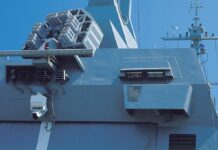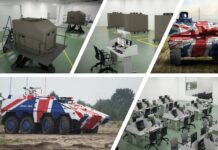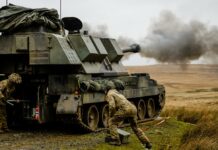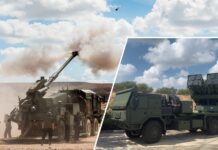When fighting a peer or near-peer adversary, there is always an imminent threat of counter fire in response to your mortars or artillery engagement. Radars and drones in all variants have proven to be effective assets in providing target information.
To defend the counter-fire threat, the Danish Army will have to change the way we deploy our heavy systems:
- Keep the crew protected during engagement;
- Hiding from drones and other reconnaissance assets in any possible way when not executing a fire mission.
- Expose the system as short as possible during firing.
- Keep the unit’s systems physically separated during the fire mission to make them a less attractive target.
- Leave the firing position immediately after firing the last round.
This is old news, but has become more relevant than ever since 2014, when a number of case studies from Ukraine showed what happens when you keep your heavy mortars or artillery in a static position for a longer period.
To fulfil these “new” requirements, the Danish Army will take advantage of a lot of new technology elements over the next couple of years.This article looks at the new
CARDOM 10 120mm mortar system:
PIRANHA 5 – Mobility and Protection
In order to keep the crew well-protected and to provide the best possible mobility for the weapon system, the mortar has been integrated with the Danish Army’s brand-new armoured personnel carrier. The Danish Army decided to replace its fleet of M113 and PIRANHA 3 vehicles with the brand-new PIRANHA 5 from General Dynamics European Land Systems-Mowag in 2015. The PIRANHA 5 offers a very high level of mobility and protection. The vehicle will be delivered in different configurations, adjusted to different army requirements and applications: Infantry, Engineers, Medical Service, command postvehicle and others.
As the latest variant the mortar version was tested in the western part of Denmark during the first half of 2019. The Army will receive a number of PIRANHA 5s with a floor-based mortar. The mortar of choice is Elbit’s CARDOM 10.
CARDOM 10 – Autonomy and Accuracy
One way to reduce the threat that the mortar team is exposed to hostile reconnaissance is to introduce systems that help to reduce the time spent on laying the mortar. The CARDOM 10 is a fully autonomous 120mm soft recoil mortar system. The system delivers effective fire support by combining the flexibility and effectiveness of accurate mortar fire with the exceptional tactical mobility of the PIRANHA 5. This combination allows the commander to deploy his systems in different formations depending on the threat including all formations from close together to spread over a larger area, thus forcing the enemy to use more resources to engage the unit.
The CARDOM 10 is a derivative of the combat-proven 120mm CARDOM which is an open hatch, muzzle loaded and turntable mounted mortar used by the US Army, the Israeli defence forces and other countries.

CARDOM 10 uses a longer barrel in order to achieve ranges of up to 10 km with extended range ammunition. This explains the designation CARDOM 10. The mortar utilises an auto-laying system based on an electric drive for elevation and traverse, also enabling MRSI (Multiple Rounds Simultaneous Impact) capabilities. In case of a power supply failure or a breakdown of the computer or navigation system, the mortar can be laid manually using the backup handles and an optical sight unit known from the ground-based systems.
The Fire Control System (FCS) is based on NATO’s S4 software. Combined with meteorological information (METGM or METCM) and information from the muzzle velocity radar the FCS provides a very high accuracy level. In combination with the auto-laying of the mortar, this technology will improve firing accuracy and reduce the need for adjusting the fire before fire for effect.
These are major steps to reduce time in the firing position and to avoid the possibility of a counter fire. The FCS is interfaced to the Army’s battle management system and the call-for-fire procedure is now based on digital communication means. If needed, the observer can call for fire via voice-communication, too. Besides, the system is equipped with a semi-automatic loading system that enables the crew to easily control and fire with a rate of up to 10 rounds per minute. Compared to manual loading of the mortar the loading system reduces the physical stress on the crew, thus improving the team’s effectiveness.
Final Test and Delivery
The complete system was subject to an extensive test programme from February until July of this year, including mobility tests and applying maximum stress on the weapon. The noise and pressure during engagement were measured to provide best possible environmental conditions for the crew. The tests also included live firing in tactical scenarios to consider the overall performance. These scenarios were based on the “shoot n´ scoot” principle. The system met all requirements for fast and accurate fire and proved to be a very effective system for the future – ready to meet the “new” threats on the battlefield.
CARDOM 10 Trials in Denmark. (Video: DALO)
The systems will be organised in platoons with four systems in each platoon in support of the infantry battalions. The first systems will be delivered in the early part of 2020 with deliveries to be completed at the beginning of 2021.

Muzzle Velocity Radar (MVR)
Each CARDOM 10 mortar system will be equipped with a MVRS-700SC muzzle velocity radar system from Weibel in Denmark. Many parameters, such as temperature, humidity and barrel conditions influence a mortar bomb’s muzzle velocity. It is pivotal to compensate for these parameters and improve accuracy by adjusting individual mortar settings according to precise measured muzzle velocity. The radar system is integrated with the FCS and consists of an antenna and a processor.The antenna unit contains all necessary electronics and an acoustic trigger. Its trigger and Doppler signals are digitised by the processor unit and stored for digital analysis.
Autor: Major Michael Johnsson is Head of Mortar Element, 1 Artillery Battalion, Danish Artillery Regiment











